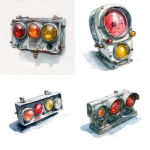Explore the Best AI Image Gallery

Beyond the Canvas: How Edge Computing Empowers Creative Expression
The realm of creativity is constantly evolving, driven by technological advancements that push the boundaries of artistic expression. In recent years, edge computing has emerged as a powerful force, enabling real-time data processing and decentralized intelligence. This paradigm shift holds immense potential for revolutionizing the creative industry, empowering artists, designers, and innovators to explore new frontiers.
Understanding Edge Computing: The Foundation for Creative Innovation
Edge computing brings computation and data storage closer to the source of data generation. Instead of relying on centralized cloud servers, processing occurs at the edge—devices themselves, local networks, or nearby servers. This decentralized approach offers several advantages for creative applications:
- Real-time responsiveness: Edge computing eliminates latency, enabling instantaneous data processing and interaction. Imagine sculpting a 3D model with real-time feedback on your digital canvas or choreographing a dance performance synchronized with live sensor data.
- Enhanced interactivity: Artists can create immersive experiences by integrating edge computing into interactive installations, augmented reality (AR) applications, and virtual reality (VR) environments. Users can directly influence the creative output through their actions and movements.
- Data privacy and security: Processing data at the edge minimizes the need to transmit sensitive information to centralized servers, enhancing privacy and security for both artists and their audiences.
Edge Computing Applications in the Creative Industry
The possibilities are vast, spanning various creative disciplines:
1. Visual Arts:
- Interactive installations: Artists can use edge computing to create dynamic installations that respond to visitor interaction, transforming spaces into living artworks.
- Generative art: Algorithms powered by edge devices can generate unique visual compositions based on real-time data streams, pushing the boundaries of artistic creation.
- Personalized experiences: Edge computing enables AR applications that overlay digital artwork onto physical spaces, tailoring the creative experience to individual viewers.
2. Music and Performance:
- Real-time music generation: Musicians can use edge-enabled instruments and software to create improvisational compositions based on sensor data, audience feedback, or environmental stimuli.
- Immersive sound design: Edge computing allows for spatially aware audio experiences, creating dynamic soundscapes that adapt to the listeners position and movement within a performance space.
3. Film and Animation:
- Live action compositing: Edge devices can process visual effects in real time during filming, enabling seamless integration of CGI elements with live-action footage.
- Dynamic animation: Artists can leverage edge computing to create animations that respond to user input or environmental factors, adding an interactive dimension to storytelling.
Ethical Considerations in Edge Computing for Creativity
As with any powerful technology, ethical considerations must guide the development and deployment of edge computing in the creative industry:
- Data privacy: Ensuring user consent and protecting sensitive data collected through edge devices is paramount. Transparency about data usage and clear opt-in mechanisms are essential.
- Bias and fairness: Algorithms used in creative applications can inherit biases from the data they are trained on. Its crucial to address potential biases to ensure equitable and inclusive creative outcomes.
- Access and equity: The benefits of edge computing should be accessible to all, regardless of their technical expertise or resources. Initiatives promoting digital literacy and providing equitable access to technology are vital.
Future Trends in Edge Computing for Creative Expression
The convergence of edge computing with other emerging technologies will further shape the creative landscape:
- Increased interconnectivity: Edge devices will seamlessly communicate and collaborate, enabling more complex and collaborative creative projects.
- AI-powered creativity: Artificial intelligence integrated with edge computing will empower artists to explore new forms of expression, from generating original artwork to composing music.
- Personalized creativity: Edge computing will enable highly personalized creative experiences tailored to individual preferences and tastes.
In conclusion, edge computing is poised to revolutionize the creative industry by empowering artists with real-time responsiveness, enhanced interactivity, and personalized creative experiences. As we navigate this transformative landscape, ethical considerations must guide our path, ensuring that these technologies are used responsibly and equitably to foster a more inclusive and innovative future for creativity.



](https://images.ai-img.art/thumbnails/150/8c320ce9aefbbb5b9ec5fd4e1d0fba7388f0fff5b6c2e2f14077cad3008f291d.webp)



](https://images.ai-img.art/thumbnails/150/3c5dc62bba83cc9919c20ebfec8430d31e821cef586a2753dd85ef26d77d480a.webp)

](https://images.ai-img.art/thumbnails/150/1accb5453f2335686b162f0a879c7ce73a18516a33868f214a16bdaf95beeb5a.webp)

](https://images.ai-img.art/thumbnails/150/1d7b3a908141474d50d90721c394db29c0cb5404d685ae70ea60430c18e905b7.webp)
](https://images.ai-img.art/thumbnails/150/3e8c063b4357fc743a3c6e49a3145ee31b2dcecc018c38d2db8f97bf3e3fda3f.webp)










